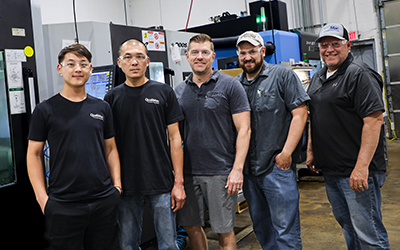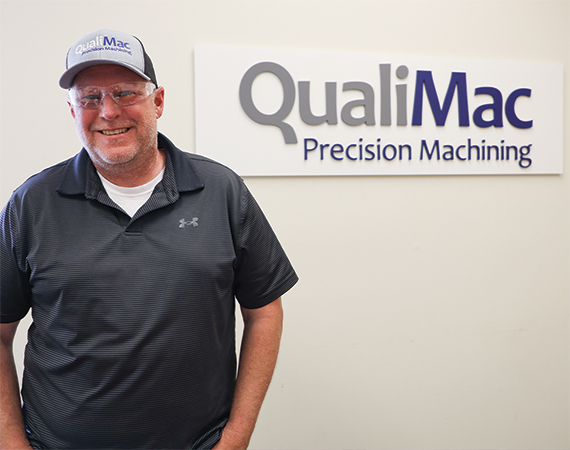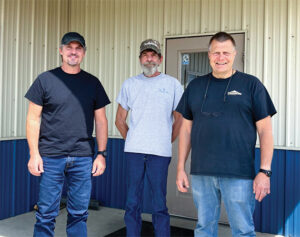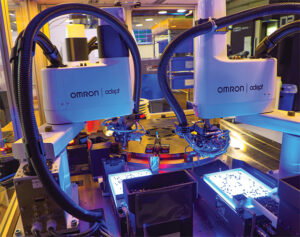Leaders at a suburban metal fabricator business estimate that centralizing part of their shop floor is saving hours of work each week and producing considerably more revenue each month.
QualiMac is a 33-person job shop in Bloomington that produces custom metal component parts that stamp names and numbers onto new credit cards, for instance, or parts for machines that print passports. Helped by Enterprise Minnesota consultants, QualiMac administrators reorganized and centralized a portion of the shop floor to reduce the number of figurative and literal steps workers there need to take in a given day.

That meant positioning a computer in the center of the shop floor so staff don’t have to walk to a far end of the building to get the necessary schematics for a fresh job; standardizing each workstation so they don’t have to head to another area to find necessary tools; putting production schedules in a more convenient place, and more.
Relatively small changes can be crucial. There are enough manufacturers in the Twin Cities and the Midwest that, if one isn’t running as efficiently as possible, it can be bested by a competitor, according to Brady Bjorgaard, QualiMac’s president.
“You’re going to get outbid,” he says. “Somebody’s going to be doing it better and quicker.”
Shaving a few minutes at a time from each employee’s routine has reportedly added up.
In the aggregate, the five workers in that section of the shop are spending about 100 fewer minutes walking to and fro each day, according to Greg Hunsaker, a business growth consultant at Enterprise Minnesota. Company staff estimate that and other efficiencies could produce an additional $1.5 million in total sales over the coming three years.
More broadly, QualiMac staff are working less overtime and the company itself reported greater monthly revenue with 90% on-time deliveries, according to Bjorgaard.
“Profits are up,” Bjorgaard says. “Everything’s up. We’re running really well right now.”
The company is one of four Twin Cities-area manufacturers with the same owner. QualiMac and Enterprise Minnesota staff revamped a specific part of the shop floor at one of those companies because they wanted to start small and get workers themselves on board.
“We took a smaller area with good employees where we knew we’d get buy-in, and then we basically perfected that area,” Bjorgaard says. “And now we’re spreading it to the other areas of the building.”
At QualiMac, company staff and Enterprise Minnesota consultants stood on a figurative “X” for 30-plus minutes and noted where there might be waste while they watched staff fashion parts with vertical mills. They saw that workers frequently had to leave their station to retrieve tools, load new digital schematics, and so on.
“Why is all this walking happening?” Hunsaker asks rhetorically. “Why did they have to go and get information? Why is it not right there? Why do they have to go to tools? Why are the tools not right there for them? Why do they have to walk into this other room 50 feet away to go get drawings to do their job?”
Tools in that section of the shop now fall into three tranches: those used multiple times each day, those used more sparingly, and those used, perhaps, only a few times each year, according to Bjorgaard.
Staff in the revamped vertical mill area are excited about the new layout, Bjorgaard reports.
“Everything’s right there at their fingertips,” he says.
The rework is part of a “job methods” program that is itself part of a “training within industry” technique that traces its roots to World War II, when American women quickly had to learn machining and manufacturing jobs to support the war effort while the men who’d typically held those jobs were deployed overseas, Hunsaker explains.
In a nutshell, consultants evaluate a given process at a company, try to improve it, then standardize it so new hires can more easily learn the ropes.

After Enterprise Minnesota consultants observe staff at a given company, they try to weed out actions that aren’t necessary, according to Kari Rusing, a business development advisor at Enterprise Minnesota.
“We document it so that when we teach that job to somebody else, we’re teaching them the most efficient way to do that job and think about it,” Rusing explains. “We don’t want to judge the people, judge the movement, or judge how they’re doing things, but, rather, we want to create the most efficient process that’s going to give us the best quality product at the end of the day.”
Once QualiMac has standardized each task, Rusing says, the next step might be “job instruction,” which means placing designated trainers in each area of the shop. But that might be a year or more down the road while the company adjusts to the new processes it’s putting in place.
“It does take time,” Rusing says.
Return to the Fall 2024 issue of Enterprise Minnesota® magazine.


